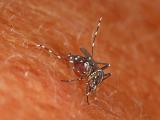Sep 27, 2010
Australia finds slightly higher kids' seizure rates for pandemic H1N1 vaccine
In its review of suspected side effects from the 2009 H1N1 vaccine, Australia's drug regulatory authority recently reported an increased rate of febrile seizures in children, though the rate was lower than that seen with one of the seasonal flu vaccines, according to a Sep 22 report from country's Therapeutic Goods Administration (TGA). Both of the vaccines are made by the same company, CSL Ltd., based in Australia. Increased reports of febrile convulsions in children that surfaced in late April led to the suspension of seasonal flu vaccination in Australian children age 5 and younger. Officials have not determined a cause for the increased reports of the seizures, but the company withdrew the product from the market, pending an investigation into the reports. In the TGA's report, regulators said from Sep 30, 2009, through Sep 17, 2010, the agency had received 48 reports of febrile convulsions in children after receiving CSL's Panavax vaccine. In nine instances children had received other immunizations at the same time. It said a working group that explored the reports of febrile seizures in kids who received Panavax estimated that the rate was between 0.8/1,000 to .18/1,000 doses administered, which is less than the .7/1,000 estimated rate for CSL's seasonal flu vaccine. The TGA also said the rate of febrile seizures in children who received the pandemic vaccine is within predicted rates for influenza vaccines in general. Dr Jim Bishop, Australia's chief medical officer, downplayed concerns, noting that the final number of verified reports will likely be lower and that the seizure rate for Panavax was a fraction of what was reported for this year's seasonal vaccine, the Sydney Morning Herald reported today. He said the rate of seizures with the pandemic vaccine was four times higher than usual, much lower than the 50-times-higher rate seen for CSL's seasonal flu vaccine.
Sep 28 Sydney Morning Herald story
European panel endorses prepandemic H5N1 vaccine from Novartis
A committee of the European Medicines Agency (EMA) last week endorsed a prepandemic H5N1 influenza vaccine made by Novartis, signaling its likely approval by the EMA for marketing in the European Union later this year. The EMA's Committee for Medicinal Products for Human Use (CHMP) recommended approval of the vaccine, called Aflunov, for use in adults, according to statements from Novartis and the EMA. In a Sep 24 statement, Novartis said a marketing authorization for the vaccine is expected by the end of this year. In clinical trials, two doses of Aflunov generated antibody titers considered protective against the vaccine strain of H5N1 in more than 85% of volunteers, and it also triggered cross-reactive antibodies against other H5N1 strains that have caused human disease, the company said. The vaccine contains Novartis's MF59 adjuvant. The company said the vaccine may offer a way to provide healthcare and emergency workers with some advance protection against the threat of an H5N1 pandemic. The CHMP said it began reviewing Novartis's Aflunov application in December 2009.
Sep 24 Novartis news release
CHMP meeting highlights with information on Aflunov
France confirms two cases of indigenous chikungunya
On the heels of reports of the first cases of locally transmitted dengue fever in the French Riviera region, French health officials have released an alert after detecting two cases of indigenous chikungunya infection in the same region. In an Agence France-Presse (AFP) story yesterday, authorities said two 12-year-old girls in the town of Frejus have contracted the virus, which, like dengue, is carried by mosquitoes. The girls had not traveled to countries in which the disease is endemic. A ProMed-mail commentary on the cases said they were "not surprising" and said the risk of chikungunya was highlighted in a Jul 27 French government warning. The commentary from ProMed-mail, the Internet reporting system of the International Society for Infectious Diseases, said, "This risk is due to the presence of the Asian tiger mosquito (Aedes albopictus), mosquito populations in southern France, and frequent imported cases of chikungunya virus-infected travelers." In 2007, an outbreak of chikungunya fever in Italy affected more than 200 people.
Sep 26 AFP article
Sep 26 ProMed-mail report
Jul 27 French government warning
2007 Italy outbreak summary report
Heroin anthrax investigation raises new questions
Anthrax infections in UK heroin users may become endemic, and the rising number of cases has led to a fourth form of the disease, injectional anthrax, public health officials said earlier this month at a Health Protection Agency (HPA) conference, according to a Sep 24 report on the Emerging Health Threats Forum Web site. The forum is supported by the HPA. Investigations still haven't determined how or when the drug became contaminated, though authorities have found that older drug users are more commonly affected and that initial tests on the anthrax strain suggests that it belongs to the "trans-Eurasian" strain that closely resembles those found in the Near- and Middle East. Cases have been reported since December 2009, with the latest case in a 29-year-old English man who died from the disease in late August. Some suspected that the heroin could have been smuggled in an anthrax-contaminated goat skin, though others have not ruled out intentional contamination or a tainted ingredient used to cut the pure heroin. According to a Sep 25 ProMed-mail post, the anthrax-laced heroin has killed 16 people so far, 13 in Scotland and 3 in England.
Sep 25 ProMed-mail post
















